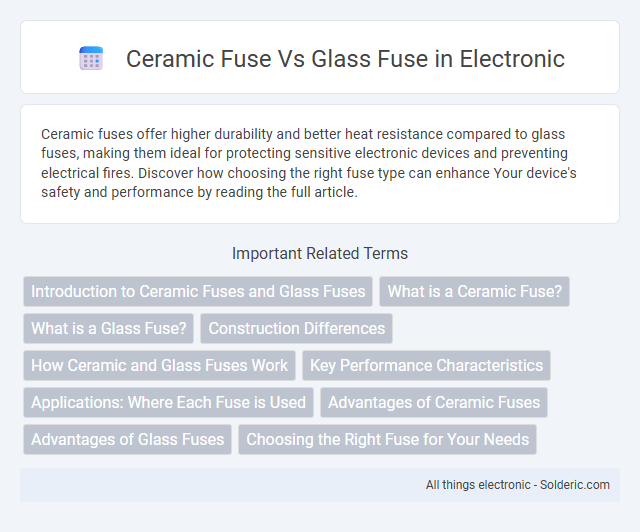Ceramic fuses offer higher durability and better heat resistance compared to glass fuses, making them ideal for protecting sensitive electronic devices and preventing electrical fires. Discover how choosing the right fuse type can enhance Your device's safety and performance by reading the full article.
Comparison Table
| Feature | Ceramic Fuse | Glass Fuse |
|---|---|---|
| Material | High-strength ceramic | Transparent glass |
| Durability | High, resists heat and pressure | Lower, prone to breakage |
| Visibility | Opaque, limited internal inspection | Transparent, easy visual inspection |
| Breaking Capacity | Higher interrupt rating | Lower interrupt rating |
| Application | Industrial, automotive, high power circuits | Electronics, low power devices |
| Cost | Generally higher | Generally lower |
| Safety | Better resistance to explosion | Risk of shattering under fault conditions |
Introduction to Ceramic Fuses and Glass Fuses
Ceramic fuses and glass fuses serve as essential overcurrent protection components in electrical circuits, with ceramic fuses constructed from durable, heat-resistant ceramic material enabling higher interrupting ratings and enhanced safety under fault conditions. Glass fuses feature a transparent glass tube that allows for easy visual inspection of the fuse element, making them ideal for low to moderate current applications. Both fuse types play critical roles in safeguarding electronics, but ceramic fuses offer superior thermal and mechanical endurance compared to the more fragile glass fuses.
What is a Ceramic Fuse?
A ceramic fuse is an electrical safety device made from a durable ceramic material designed to protect circuits from overcurrent by melting its internal wire when excessive current flows. Unlike glass fuses, ceramic fuses withstand higher temperatures and pressure, reducing the risk of explosions or fire hazards in electrical systems. Your choice of a ceramic fuse ensures enhanced reliability and safety in high-stress or high-voltage applications.
What is a Glass Fuse?
A glass fuse is a cylindrical electrical safety device with a thin metal wire encased in a transparent glass tube, designed to protect circuits by breaking the connection if current exceeds a safe level. The transparency of the glass allows for easy visual inspection to determine if the fuse has blown. You can rely on glass fuses in low-voltage applications where quick visual diagnosis is essential, though they offer less durability compared to ceramic fuses.
Construction Differences
Ceramic fuses feature a robust, heat-resistant ceramic body that provides superior durability and thermal stability compared to the fragile glass casing of glass fuses. The ceramic construction allows them to withstand higher surge currents and harsh environmental conditions without compromising performance. Your choice between ceramic and glass fuses should consider these structural differences, especially for applications requiring enhanced safety and reliability.
How Ceramic and Glass Fuses Work
Ceramic fuses and glass fuses both protect electrical circuits by interrupting excessive current flow, but they differ in material and performance. Ceramic fuses use a high-strength ceramic body to contain arc energy during fuse operation, allowing them to handle higher temperatures and surge currents more effectively than glass fuses. Glass fuses provide visual indication of fuse status through their transparent casing but are less capable of withstanding high heat and transient currents compared to ceramic fuses.
Key Performance Characteristics
Ceramic fuses offer higher breaking capacity and better thermal resistance compared to glass fuses, making them ideal for applications requiring robust performance under high fault currents. Glass fuses provide clear visual inspection of the element condition, allowing for easy monitoring of fuse status in low to moderate current circuits. Your choice depends on whether you prioritize enhanced durability and safety with ceramic fuses or straightforward fuse status visibility with glass fuses.
Applications: Where Each Fuse is Used
Ceramic fuses are commonly used in high-current and high-temperature applications such as automotive, industrial machinery, and power supplies due to their durability and ability to withstand extreme conditions. Glass fuses are typically found in low-current, low-voltage devices like consumer electronics and household appliances because of their clear casing that allows for easy visual inspection of the fuse element. Your choice between ceramic and glass fuses should depend on the operating environment and specific electrical requirements of your application.
Advantages of Ceramic Fuses
Ceramic fuses offer superior thermal and mechanical durability compared to glass fuses, enabling them to withstand higher fault currents and extreme temperature fluctuations without cracking. Their non-transparent, robust construction provides enhanced protection against explosions and fire hazards during electrical faults, ensuring increased safety for your circuits. These advantages make ceramic fuses ideal for high-stress applications where reliability and safety are critical.
Advantages of Glass Fuses
Glass fuses offer clear visibility of the fuse element, enabling easy inspection and quick identification of blown fuses without the need for specialized tools. They typically provide faster response times to overcurrent conditions, protecting sensitive electronic components with greater precision. Their lightweight and compact design makes them ideal for use in various consumer electronics and automotive applications.
Choosing the Right Fuse for Your Needs
Ceramic fuses offer higher thermal and breaking capacity compared to glass fuses, making them ideal for protecting circuits with higher current loads or potential surges. Glass fuses provide visual inspection benefits due to their transparent casing, allowing you to quickly identify fuse status but are generally suited for lower current applications. Selecting the right fuse depends on your circuit's voltage, current requirements, and the need for durability or easy inspection.
Ceramic Fuse vs Glass Fuse Infographic

 solderic.com
solderic.com